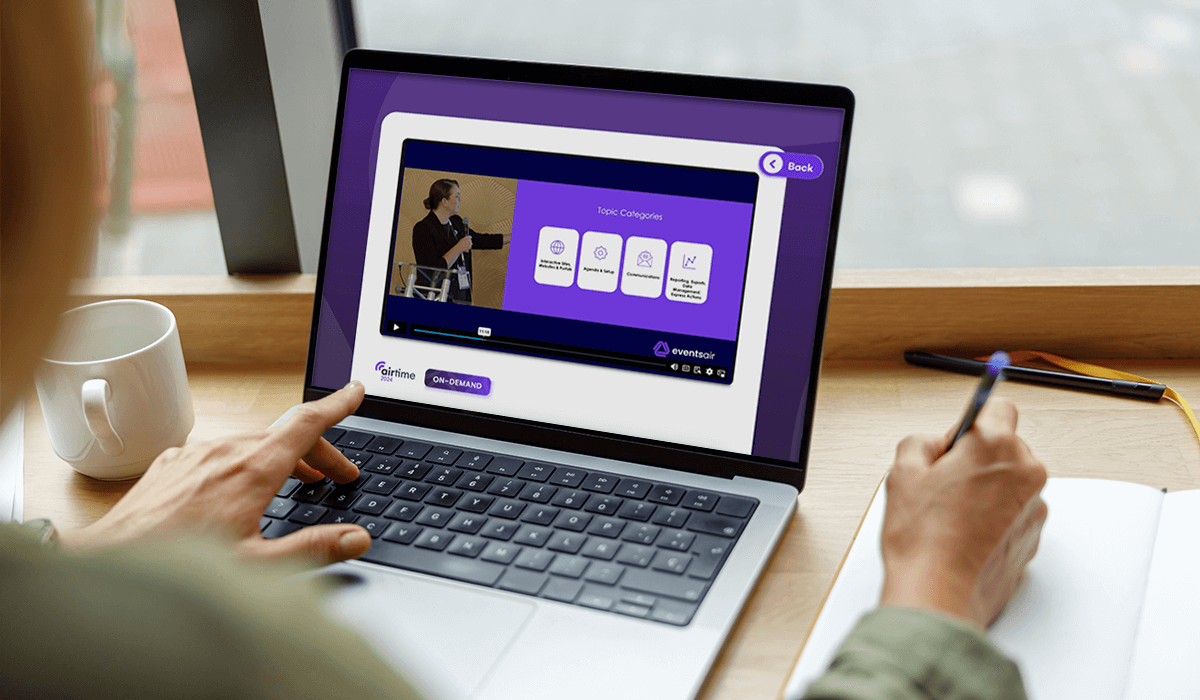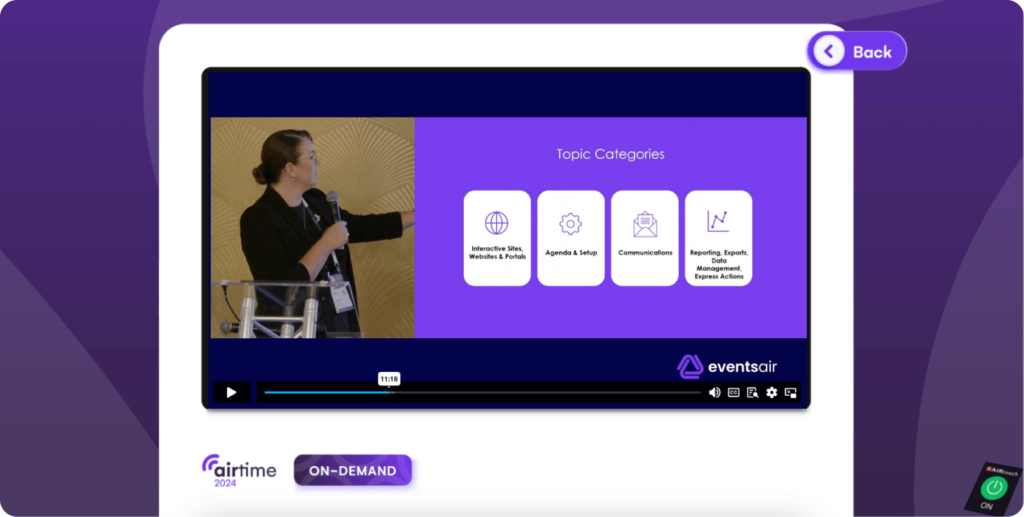How To Manage Hybrid Events: Steps, Tips & Best Practices

Hybrid events combine the benefits of in-person gatherings with the reach of virtual attendance.
While they offer unique opportunities, managing them effectively can be challenging without the right approach and tools. Properly balancing the dual experiences requires careful coordination and tailored engagement strategies.
In this EventsAir article, we’ll cover step-by-step guidance for managing hybrid events, highlight important tools to streamline the process, and offer expert insights to ensure both live and virtual audiences have an impactful experience.
What is hybrid event management?
Hybrid event management blends physical and virtual experiences into a single, cohesive event. It’s not just livestreaming your in-person event—it’s creating an environment where both remote and on-site attendees can fully participate, network, and engage with content.

What makes hybrid events different is their dual focus. Every element needs to work for both audiences:
- Sessions that engage both in-person and virtual participants
- Networking that connects all attendees, regardless of location
- Content delivery that’s accessible and impactful across formats
- Technology that enables real-time interaction between audiences
How to plan & manage amazing hybrid events
1. Define your unified event strategy
A unified event strategy isn’t just about having two different experiences running in parallel – it’s about creating one cohesive program that serves both in-person and virtual attendees effectively. This means thinking through how every element of your event will work for both audiences from the start… not treating virtual components as an afterthought.
Take Salesforce’s World Tour Sydney as an example.

They turned what could have been a disjointed experience into a seamless event by using a “digital-first” approach. Virtual attendees weren’t just watching a live stream—they were participating in real-time polls that influenced discussions, networking with on-site attendees, and accessing exclusive digital content between sessions.
And, this is exactly what EventsAir accomplished at our recent customer conference, AirTime. Global audiences had the chance to tune in live to AirTime in Brisbane. All attendees could actively participate in live polls, Q&A, gamification and more – regardless of their location.
Here’s what a strong unified strategy typically includes:
Goals and metrics
Consider setting targets for:
- Attendance ratios between virtual and in-person audiences
- Engagement rates for interactive elements
- Session completion rates
- Networking participation
- Lead generation or conversion goals
Budget planning
Your budget allocation might include:
- Technology infrastructure
- Production quality and AV setup
- Platform licensing
- On-site logistics
- Virtual engagement tools
The key is that these elements should be planned together, not as separate initiatives. When planning your strategy, remember that what works for one organization might not work for another—your specific goals, audience size, and event type will all influence how you structure your approach.
2. Plan your technology stack
Creating an effective technology stack is crucial for delivering seamless hybrid experiences. You’ll need a mix of hardware, software, and infrastructure that can handle the unique demands of blending in-person and virtual elements.
What do you really need to pull off a successful hybrid event? Here are the four main categories:
| Tool | Key Features |
| Event Management Software | – Registration and check-in for both audiences – Agenda and session management – Attendee engagement features like live polls, Q&A, and networking – Exhibitor and sponsor showcases – Analytics and reporting |
| Streaming and Production Software | – Encoders to convert video signals for live streaming – Switchers for seamless transitions between content sources – Cameras and microphones optimized for live events – Reliable internet connectivity, including backup solutions |
| Engagement and Networking Software | – Mobile event apps for easy access to agendas, content, and networking – Gamification and challenges to drive participation – AI-powered matchmaking to connect like-minded attendees – Virtual meeting rooms and 1:1 video chats for face-to-face interaction – Social media integrations for extended conversations |
| On-Site Software | – Contactless check-in and badge printing – Tracking of session attendance and foot traffic – Lead retrieval and qualification for exhibitors – Digital signage for wayfinding and announcements – Cashless payments for concessions and merchandise |
Our recommendation? Minimize the number of tools in your stack (and the complexity of your workflows) by opting for all-in-one solutions like EventsAir. We help event organizers manage every aspect of their hybrid events – from registration and agenda management to live production and post-event analytics – all without switching between tools.
That said, integration is still key. You need to make sure all your tools can talk to each other. Look for an event management platform that plays well with the other key tools in your stack, like your CRM, marketing automation software, and analytics platforms.
EventsAir’s open API makes it easy to connect your favorite tools and create a truly customized hybrid event ecosystem.
3. Design content for both audiences
How do you create presentations that captivate both your in-person and virtual attendees? The key is collaboration. Work closely with your speakers to help them adapt their content for a hybrid setting by:
- Sharing resources and templates to guide them in structuring their presentations for maximum impact.
- Teaching them how to engage with virtual tools they might not be familiar with – whether that’s a live chat, Q&A system, or poll.
- Creating guidelines that push speakers to create content and presentations that appeal to both formats.
- Making your live stream more engaging by showcasing your presenters, not just the slides—it’s a simple tweak that delivers BIG results for your virtual audience
At the same time, it’s important that you don’t forget the uniqueness of both formats (in-person and virtual) independently. Creating exclusive experiences isn’t a negative – it shows attendees that you really value their specific mode of participation.
Consider offering virtual-only content, such as:
- Exclusive interviews with keynote speakers
- Behind-the-scenes tours of the event space
- Networking sessions tailored for virtual attendees
For your in-person audience, provide opportunities that capitalize on the face-to-face setting, like:
- Hands-on workshops and demonstrations
- Intimate roundtable discussions
- Personalized meet-and-greet sessions with speakers
4. Ensure seamless AV and streaming setup
Your event’s technical setup can make or break the experience for virtual attendees. A choppy stream or garbled audio will send them running for the exit—and they won’t come back. Getting this right means investing in both equipment and expertise.
Let’s start with equipment essentials:
- Professional-grade cameras positioned for multiple angles
- High-quality audio capture for both in-room and streaming audiences
- Reliable internet connection with redundant backup
- Professional streaming encoder to maintain quality
- Dedicated hardware switcher for smooth transitions
When planning your setup, consider the following:
- High-quality microphones and sound systems
- Multiple camera angles to provide dynamic visuals
- Backup equipment to mitigate risk
Choosing a streaming solution that integrates seamlessly with your event platform is equally important. EventsAir offers comprehensive virtual and hybrid event support, including:
- AIRCast producer: Managing sessions from start to finish, including speaker briefings, live Q&A, polling, pre-presentation greenroom, and live vision switching.
- Premium support: Access to specialist Technical Directors and Live Support Agents, ready to assist with any technical issues during the event.
- 3D virtual environments: Visually rich, multi-page sites incorporating agendas, speakers, virtual exhibition halls, and 3D foyers featuring sponsor branding.
- Virtual on-demand content: Netflix-esque viewing experiences for live or on-demand attendees, with multi-page sites featuring virtual content alongside agendas, speakers, sponsors, and exhibitors.
During the event, your technical team should be vigilant in monitoring the live stream, ready to quickly resolve any problems that may occur. Clear communication between your on-site AV crew and virtual support staff is key to ensuring a seamless experience for all attendees.
5. Monitor engagement and gather feedback
Monitoring engagement during your hybrid event is essential for real-time improvements and post-event analysis. Use data to track attendance, interaction rates, and session popularity, ensuring both in-person and virtual attendees remain involved throughout the event.
Make sure you’re tracking:
- Session participation: Measure active involvement, including questions asked and polls answered.
- Feedback scores: Collect post-session ratings and comments.
- Drop-off rates: Identify when and where virtual attendees disengage.
EventsAir’s analytics and reporting tools provide real-time data insights, allowing organizers to assess engagement and make on-the-fly adjustments. This capability helps maintain audience interest and informs future strategy development.
Encourage attendees to provide feedback using mobile app surveys and live chat prompts. Analyze feedback immediately to address any ongoing issues and ensure a smooth event experience. Post-event, use the collected data to identify successful elements and areas needing improvement, tailoring your next event based on these learnings.
This feedback loop not only enhances current event delivery but also fosters continuous growth in your hybrid event management approach.
Mastering hybrid event management with the right tools
Managing hybrid events successfully requires strategic planning, technology integration, and continuous audience engagement. By following these steps, you can create an impactful event that satisfies both in-person and virtual participants. To further enhance your management process, consider leveraging EventsAir.
EventsAir provides comprehensive hybrid event solutions, including live streaming, attendee engagement tools, and robust analytics. These features help event organizers deliver seamless experiences, streamline coordination, and maximize audience participation across all formats.
Enhance your hybrid event management strategy with EventsAir’s powerful event tools today.



